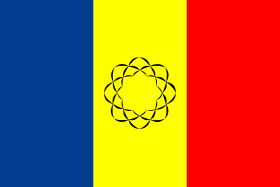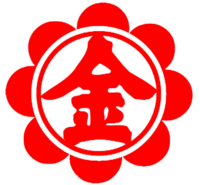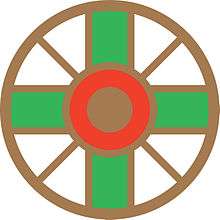Japanese new religions

Japanese new religions are new religious movements established in Japan. In Japanese they are called shinshūkyō (新宗教) or shinkō shūkyō (新興宗教). Japanese scholars classify all religious organizations founded since the middle of the 19th century as "new religions"; thus, the term refers to a great diversity and number of organizations. Most came into being in the mid-to-late twentieth century and are influenced by much older traditional religions including Shinto, Buddhism, and Hinduism. Western influences include Christianity, the Bible and the writings of Nostradamus.[1][2]
Before World War II
In the 1860s Japan began to experience great social turmoil and rapid modernization. As social conflicts emerged in this last decade of the Edo period, known as the Bakumatsu period, some new religious movements appeared. Among them were Tenrikyo, Kurozumikyo and Oomoto, sometimes called Nihon Sandai Shinkōshūkyō (literally Japan's three large Shinkōshūkyō), which were directly influenced by Shinto (the state religion) and shamanism.
The social tension continued to grow during the Meiji period, affecting religious practices and institutions. Conversion from traditional faith was no longer legally forbidden, officials lifted the 250-year ban on Christianity, and missionaries of established Christian churches reentered Japan. The traditional syncreticism between Shinto and Buddhism ended and Shinto became the national religion. Losing the protection of the Japanese government which Buddhism had enjoyed for centuries, Buddhist monks faced radical difficulties in sustaining their institutions, but their activities also became less restrained by governmental policies and restrictions.
The Japanese government was very suspicious towards these religious movements and periodically made attempts to suppress them. Government suppression was especially severe during the early 20th century, particularly from the 1930s until the early 1940s, when the growth of Japanese nationalism and State Shinto were closely linked. Under the Meiji regime lèse majesté prohibited insults not only against the Emperor and his Imperial House, but also against some major Shinto shrines which were believed to be tied strongly to the Emperor. The government strengthened its control over religious institutions that were considered to undermine State Shinto or nationalism, arresting some members and leaders of Shinshukyo, including Onisaburo Deguchi of Oomoto and Tsunesaburō Makiguchi of Soka Kyoiku Gakkai (now Soka Gakkai), who typically were charged with violation of lèse majesté and the Peace Preservation Law.
After World War II
Background
After Japan lost World War II, its government and policy changed radically during occupation by Allied troops. The official status of State Shinto was abolished, and Shinto shrines became religious organizations, losing government protection and financial support. Although the Occupation Army (GHQ) practiced censorship of all types of organizations, specific suppression of Shinshūkyō ended.
GHQ invited many Christian missionaries from the United States to Japan, through Douglas MacArthur's famous call for 1,000 missionaries. Missionaries arrived not only from traditional churches, but also from some modern denominations, such as Jehovah's Witnesses. The Jehovah's Witnesses missionaries were so successful that they have become the second largest Christian denomination in Japan, with over 210,000 members (the largest is Catholicism with about 500,000 members). In Japan, Jehovah's Witnesses tend to be considered a Christianity-based Shinshūkyō, not only because they were founded in the 19th century (as were other major Shinshūkyō), but also because of their missionary practices, which involve door-to-door visiting and frequent meetings.
Despite the influx of Christian missionaries, the majority of Shinshūkyō are Buddhist- or Shinto-related sects. Major sects include Risshō Kōsei Kai and Shinnyo-en. Major goals of Shinshūkyō include spiritual healing, individual prosperity, and social harmony. Many also hold a belief in Apocalypticism, that is in the imminent end of the world or at least its radical transformation.[1] Most of those who joined Shinshūkyō in this period were women from lower-middle-class backgrounds.[2]
Soka Gakkai has a particular influence to politics since 1964, thanks to their affiliated party Komeito, later New Komeito. In 1999, it was estimated that 10 to 20 per cent of the Japanese population were members of a Shinshūkyō.[2]
Influence
After World War II, the structure of the state was changed radically. Prior to WWII, the National Diet was restricted and the real power lay with the executive branch, in which the prime minister was appointed by the emperor. Under the new Constitution of Japan, the Diet had the supreme authority for decision making in state affairs and all its members were elected by the people. Especially in the House of Councillors, one third of whose members were elected through nationwide vote, nationwide organizations found they could influence national policy by supporting certain candidates. Major Shinshūkyō became one of the so-called "vote-gathering machines" in Japan, especially for the conservative parties which merged into the Liberal Democratic Party in 1955.
Other nations
In the 1950s, Japanese wives of American servicemen introduced the Soka Gakkai to the United States, which in the 1970s developed into the Soka Gakkai International (SGI). The SGI has steadily gained members while avoiding much of the controversy encountered by some other new religious movements in the US. Well-known American SGI converts include musician Herbie Hancock and singer Tina Turner.[3]
In Brazil Shinshūkyō, like Honmon Butsuryū-shū, were first introduced in the 1920s among the Japanese immigrant population. In the 1950s and 1960s some started to become popular among the non-Japanese population as well. Seicho-no-Ie now has the largest membership in the country. In the 1960s it adopted Portuguese, rather than Japanese, as its language of instruction and communication. It also began to advertise itself as philosophy rather than religion in order to avoid conflict with the Roman Catholic Church and other socially conservative elements in society. By 1988 it had more than 2.4 million members in Brazil, 85% of them not of Japanese ethnicity.[1]
Statistics




.jpg)

| Name | Founder | Founded | 1954 | 1974 | 1990 | 2012 |
| Nyorai-kyō (如来教) | Isson-nyorai Kino (1756-1826) | 1802 | 75,480 | 33,674 | 27,131 | 7,477 |
| Kurozumi-kyō (黒住教) | Munetada Kurozumi (1780-1850) | 1814 | 715,650 | 407,558 | 295,225 | 297,767 |
| Tenri-kyō (天理教) | Nakayama Miki (1798-1887) | 1838 | 1,912,208 | 2,298,420 | 1,839,009 | 1,199,652 |
| Honmon Butsuryū-shū (本門佛立宗) | Nagamatsu Nissen (1817-1890) | 1857 | 339,800 | 515,911 | 526,337 | 345,288 |
| Konko-kyō (金光教) | Konkō Daijin (1814-1883) | 1859 | 646,206 | 500,868 | 442,584 | 430,021 |
| Maruyama-kyō (丸山教) | Rokurōbei Itō (1829-1894) | 1870 | 92,011 | 3,200 | 10,725 | 11,057 |
| Ōmoto (大本) | Nao Deguchi (1837-1918) Onisaburō Deguchi (1871-1948) | 1899 | 73,604 | 153,397 | 172,460 | 169,525 |
| Nakayama-Shingoshō-shū (中山身語正宗) | Matsutarō Kihara (1870-1942) | 1912 | 282,650 | 467,910 | 382,040 | 295,275 |
| Honmichi (ほんみち) | Ōnishi Aijirō (1881-1958) | 1913 | 225,386 | 288,700 | 316,825 | 318,974 |
| En'nō-kyō (円応教) | Chiyoko Fukada (1887-1925 | 1919 | 71,654 | 266,782 | 419,452 | 457,346 |
| Reiyū-kai (霊友会) | Kakutarō Kubo (1892-1944) | 1924 | 2,284,172 | 2,477,907 | 3,202,172 | 1,412,975 |
| Nenpō-shinkyō (念法眞教) | Ogura Reigen (1886-1982) | 1925 | 153,846 | 751,214 | 807,486 | 408,755 |
| Perfect Liberty Kyōdan (パーフェクト リバティー教団) | Miki Tokuharu (1871-1938) Miki Tokuchika (1900-1983) | (1925)[4] 1946 | 500,950 | 2,520,430 | 1,259,064 | 942,967 |
| Seichō-no-Ie (生長の家) | Masaharu Taniguchi (1893-1985) | 1930 | 1,461,604 | 2,375,705 | 838,496 | 618,629 |
| Sōka Gakkai (創価学会) | Tsunesaburō Makiguchi (1871-1944) Jōsei Toda (1900-1956) | 1930 | 341,146 | 16,111,375 | 17,736,757[5] | 20,000,000 |
| Sekai Kyūsei-kyō (世界救世教) | Mokichi Okada (1882-1955) | 1935 | 373,173 | 661,263 | 835,756 | 835,756 |
| Shinnyo-en (真如苑) | Shinjō Itō (1906-1956) | 1936 | 155,500 | 296,514 | 679,414 | 902,254 |
| Kōdō Kyōdan (孝道教団) | Shōdō Okano (1900-1978) | 1936 | 172,671 | 417,638 | 400,720 | 184,859 |
| Risshō Kōsei-kai (立正佼成会) | Myōkō Naganuma (1889-1957) Nikkyō Niwano (1906-1999) | 1938 | 1,041,124 | 4,562,304 | 6,348,120 | 3,232,411 |
| Tenshō Kōtai Jingū-kyō (天照皇大神宮教) | Sayo Kitamura 1900-1967) | 1945 | 89,374 | 386,062 | 439,011 | 479,707 |
| Zenrin-kyō (善隣教) | Tatsusai Rikihisa (1906-1977) | 1947 | 404,157 | 483,239 | 513,321 | 132,286 |
| Ōyama Nezunomikoto Shinji Kyōkai (大山ねずの命神示教会) | Sadao Inaii (1906-1988) | 1948 | 59,493 | 826,022 | ||
| Bussho Gonenkai Kyōdan (佛所護念会教団) | Kaichi Sekiguchi (1897-1961) Sekiguchi Tomino (1905-1990) | 1950 | 352,170 | 1,210,227 | 2,196,813 | 1,277,424 |
| Myōchikai Kyōdan (妙智会教団) | Mitsu Miyamoto (1900-1984) | 1950 | 515,122 | 673,913 | 962,611 | 709,849 |
| Byakkō Shinkō-kai (白光真宏会) | Masahisa Goi (1916-1980) | 1951 | 500,000 | |||
| Agon-shū (阿含宗) | Seiyū Kiriyama (1921-) | 1954 | 500 | 206,606 | 353,890 | |
| Reiha-no-Hikari Kyōkai (霊波之光) | Hase Yoshio (1915-1984) | 1954 | 761,175 | |||
| Jōdoshinshū Shinran-kai (浄土真宗親鸞会) | Kentetsu Takamori (1934-) | 1958 | 100,000[6] | |||
| Sekai Mahikari Bunmei Kyōdan (世界真光文明教団) | Kōtama Okada(Yoshikazu Okada) (1901-1974) | 1959 | 97,838 | |||
| Honbushin (ほんぶしん) | Ōnishi Tama (1916-1969) | 1961 | 900,000[6] | |||
| God Light Association Sōgō Honbu (GLA総合本部) | Shinji Takahashi (1927-1976) | 1969 | 12,981 | |||
| Shinji Shūmei-kai (神慈秀明会) | Mihoko Koyama (1910-) | 1970 | 1988: 440,000[6] | |||
| Nihon Seidō Kyōdan (日本聖道教団) | Shōkō Iwasaki (1934-) | 1974 | 69,450 | |||
| Extra-Sensory-Perception Kagaku Kenkyūjo (ESP科学研究所) | Katao Ishii (1918-) | 1975 | 16,000[6] | |||
| Sūkyō Mahikari (崇教真光) | Yoshikazu Okada(1901-1974) | 1978 | 501,328 | |||
| Ho No Hana (法の華三法行) | Hōgen Fukunaga (1945-) | 1980 | 70,000[6] | |||
| Yamato-no-Miya (大和之宮) | Tenkei Ajiki (1952-) | 1981 | 5,000[6] | |||
| World Mate (ワールドメイト) | Seizan Fukami (1951-) | 1984 | 30,000[6] | 72,000 | ||
| Happy Science (幸福の科学) | Ryūhō Ōkawa (1956-) | 1986 | 1989: 13,300 1991: 1,527,278[6] | 1,100,000 | ||
| Aum Shinrikyo (オウム真理教) | Shōkō Asahara (1955-) | 1987 (-2000) | 0 |
Data for 2012 is from the Agency for Cultural Affairs.[7]
See also
- Religion in Japan
- Shinto sects and schools (Only some on the list count as Shinshukyo)
References
- 1 2 3 Peter B. Clarke, 1999, "Japanese New Religious Movements in Brazil: from ethnic to 'universal' religions", New Religious Movements: challenge and response, Bryan Wilson and Jamie Cresswell editors, Routledge ISBN 0415200504
- 1 2 3 Eileen Barker, 1999, "New Religious Movements: their incidence and significance", New Religious Movements: challenge and response, Bryan Wilson and Jamie Cresswell editors, Routledge ISBN 0415200504
- ↑ Eugene V. Gallagher, 2004, The New Religious Movement Experience in America, Greenwood Press, ISBN 0313328072, pages 120-124
- ↑ The (1925) date refers to the Hito-no-Michi Kyōdan, the mother organization of Perfect Liberty Kyōdan
- ↑ Sōka Gakkai has not released figures for 1989 and 1990, so this figure is the membership number for 1988,
- 1 2 3 4 5 6 7 8 Most of the statistics in these charts are from the 1991 edition of the Shūkyō Nenkan (Religion Yearbook, Tokyo: Gyōsei). Numbers marked with this footnote are from other sources reporting the organizations‘ own membership statistics around 1990.
- ↑ https://web.archive.org/web/20140827014822/http://www.bunka.go.jp/shukyouhoujin/nenkan/pdf/h24nenkan.pdf
Bibliography
- Clarke, Peter B. (1999) A Bibliography of Japanese New Religious Movements: With Annotations. Richmond : Curzon. ISBN 9781873410806; OCLC 246578574
- Clarke, Peter B. (2000). Japanese New Religions: In Global Perspective. Richmond : Curzon. ISBN 9780700711857; OCLC 442441364
- Clarke, Peter B., Somers, Jeffrey, editors (1994). Japanese New Religions in the West, Japan Library/Curzon Press, Kent, UK. ISBN 1-873410-24-7
- Dormann, Benjamin (2012). Celebrity Gods: New Religions, Media, and Authority in Occupied Japan, University of Hawaiʻi Press. ISBN 0824836219
- Dormann, Benjamin (2005). “New Religions through the Eyes of Ōya Sōichi, ’Emperor’ of the Mass Media”, in: Bulletin of the Nanzan Institute for Religion & Culture, 29, pp. 54–67
- Dormann, Benjamin (2004). “SCAP’s Scapegoat? The Authorities, New Religions, and a Postwar Taboo”, in: Japanese Journal of Religious Studies 31/1: pp. 105–140
- Hardacre, Helen. (1988). Kurozumikyo and the New Religions of Japan. Princeton: Princeton University Press. ISBN 0-691-02048-5
- Kisala, Robert (2001). “Images of God in Japanese New Religions”, in: Bulletin of the Nanzan Institute for Religion & Culture, 25, pp. 19–32
- Wilson, Bryan R. and Karel Dobbelaere. (1994). A Time to Chant. Oxford: Oxford University Press. ISBN 0-19-827915-9
- Staemmler, Birgit, Dehn, Ulrich (ed.): Establishing the Revolutionary: An Introduction to New Religions in Japan. LIT, Münster, 2011. ISBN 978-3-643-90152-1